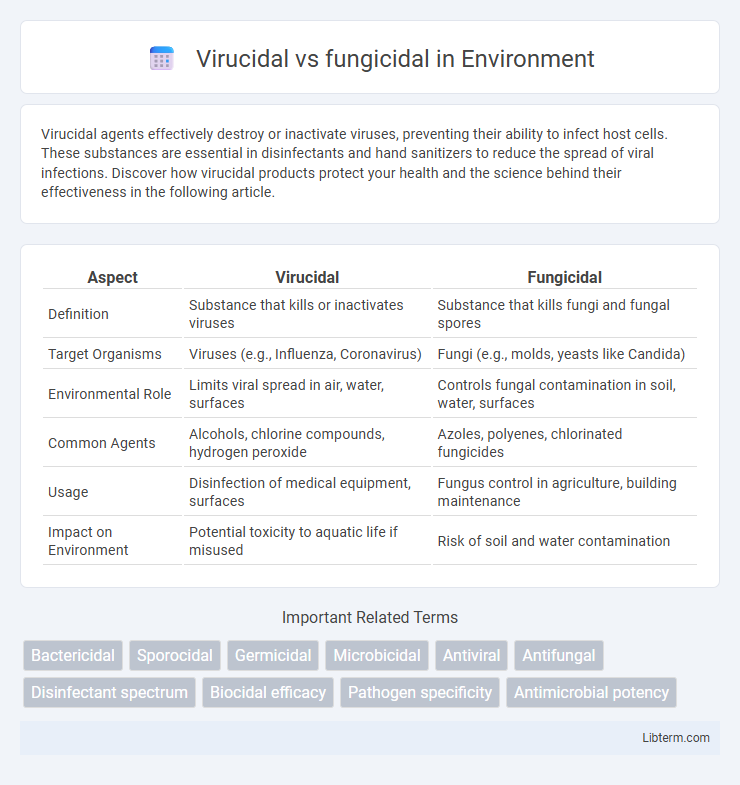Virucidal agents effectively destroy or inactivate viruses, preventing their ability to infect host cells. These substances are essential in disinfectants and hand sanitizers to reduce the spread of viral infections. Discover how virucidal products protect your health and the science behind their effectiveness in the following article.
Table of Comparison
| Aspect | Virucidal | Fungicidal |
|---|---|---|
| Definition | Substance that kills or inactivates viruses | Substance that kills fungi and fungal spores |
| Target Organisms | Viruses (e.g., Influenza, Coronavirus) | Fungi (e.g., molds, yeasts like Candida) |
| Environmental Role | Limits viral spread in air, water, surfaces | Controls fungal contamination in soil, water, surfaces |
| Common Agents | Alcohols, chlorine compounds, hydrogen peroxide | Azoles, polyenes, chlorinated fungicides |
| Usage | Disinfection of medical equipment, surfaces | Fungus control in agriculture, building maintenance |
| Impact on Environment | Potential toxicity to aquatic life if misused | Risk of soil and water contamination |
Introduction to Virucidal and Fungicidal Agents
Virucidal agents are substances designed to inactivate or destroy viruses by disrupting their structure or genetic material, making them essential in infection control and prevention. Fungicidal agents specifically target fungi, killing fungal cells by interfering with their cell membranes or metabolic processes to treat and prevent fungal infections. Understanding the distinct mechanisms and applications of virucidal and fungicidal agents is crucial for effective selection in clinical, environmental, and industrial settings.
Defining Virucidal and Fungicidal Properties
Virucidal properties refer to the ability of a substance to deactivate or destroy viruses, effectively preventing their replication and spread. Fungicidal properties characterize agents that kill or inhibit the growth of fungi, including molds and yeasts, by disrupting their cellular processes. Both properties are crucial in infection control, targeting different types of pathogens with specific mechanisms of action.
Mechanisms of Virucidal Action
Virucidal agents inactivate viruses primarily by disrupting the viral envelope or capsid, leading to the loss of infectivity. These mechanisms often involve denaturing viral proteins, damaging nucleic acids, or interfering with viral attachment to host cells. In contrast, fungicidal agents target fungal cell walls, membranes, or metabolic pathways, which are structurally distinct from viral components, explaining the specificity of virucidal action against viruses.
Mechanisms of Fungicidal Action
Fungicidal agents primarily target fungal cell walls and membranes by disrupting ergosterol synthesis, leading to increased permeability and cell lysis. These compounds also inhibit key enzymes involved in fungal metabolism, causing oxidative stress and apoptosis. Unlike virucidal agents that deactivate viruses by denaturing proteins or nucleic acids, fungicides specifically exploit fungal biological pathways to induce cell death.
Key Differences: Virucidal vs. Fungicidal Agents
Virucidal agents target and inactivate viruses by disrupting their protein coats or lipid envelopes, effectively preventing viral replication. Fungicidal agents eliminate fungi by destroying fungal cell membranes or interfering with critical cellular processes such as ergosterol synthesis. The key difference lies in their specific targets: virucidal agents combat viral pathogens, while fungicidal agents are designed to kill fungal organisms, each requiring distinct mechanisms of action to ensure efficacy in infection control.
Common Applications in Healthcare Settings
Virucidal agents are widely used in healthcare settings to disinfect surfaces and medical instruments contaminated with viruses such as influenza, HIV, and SARS-CoV-2, preventing viral transmission and healthcare-associated infections. Fungicidal products target fungal pathogens like Candida and Aspergillus, which commonly cause infections in immunocompromised patients, ensuring sterile environments in hospitals and clinics. Both virucidal and fungicidal disinfectants are critical in infection control protocols for maintaining patient safety and regulatory compliance in healthcare facilities.
Efficacy Factors: Comparing Virucidal and Fungicidal Formulations
Virucidal and fungicidal formulations differ significantly in efficacy factors due to variations in the structural complexity of viruses and fungi, with virucidal agents targeting viral envelopes or capsids, while fungicidal products disrupt fungal cell walls or membranes. Formulation efficacy depends on active ingredient concentration, contact time, and spectrum of activity, where virucidal agents often require specific surfactants or solvents to penetrate viral particles, whereas fungicides may rely on compounds like azoles or polyenes to inhibit fungal growth. Environmental conditions such as temperature, pH, and organic load also influence the effectiveness of these biocidal formulations, necessitating tailored application protocols for optimal pathogen control.
Safety and Toxicity Considerations
Virucidal agents specifically target viruses, often requiring rigorous safety evaluations due to their potent chemical composition and potential for skin irritation or respiratory issues. Fungicidal products designed to eliminate fungi may contain compounds with varying toxicity levels, necessitating careful handling to prevent adverse effects on human health and the environment. Both require strict adherence to usage guidelines and protective measures to minimize toxicity risks and ensure safe application in medical, industrial, or household settings.
Regulatory Standards and Testing Protocols
Virucidal and fungicidal agents undergo distinct regulatory standards and testing protocols to ensure efficacy and safety in microbial control. Virucidal products are evaluated following guidelines such as the EPA's Virucidal Activity Test and EN 14476, focusing on the inactivation of viruses on surfaces and in medical settings. Fungicidal agents are tested under regulations like EPA's Fungicide registration and EN 1275, targeting fungal spores and mycelium, with protocols emphasizing antifungal spectrum and persistence to meet regulatory approval.
Choosing the Right Disinfectant: Practical Recommendations
Selecting the appropriate disinfectant requires understanding the distinction between virucidal and fungicidal agents, as virucidal disinfectants effectively inactivate viruses, while fungicidal agents target fungal pathogens. Practical recommendations include assessing the surface type, pathogen risk, and exposure duration to ensure optimal efficacy in infection control. Using disinfectants with proven efficacy against the targeted pathogen type reduces contamination and enhances safety in healthcare, laboratory, and household settings.
Virucidal Infographic

 libterm.com
libterm.com